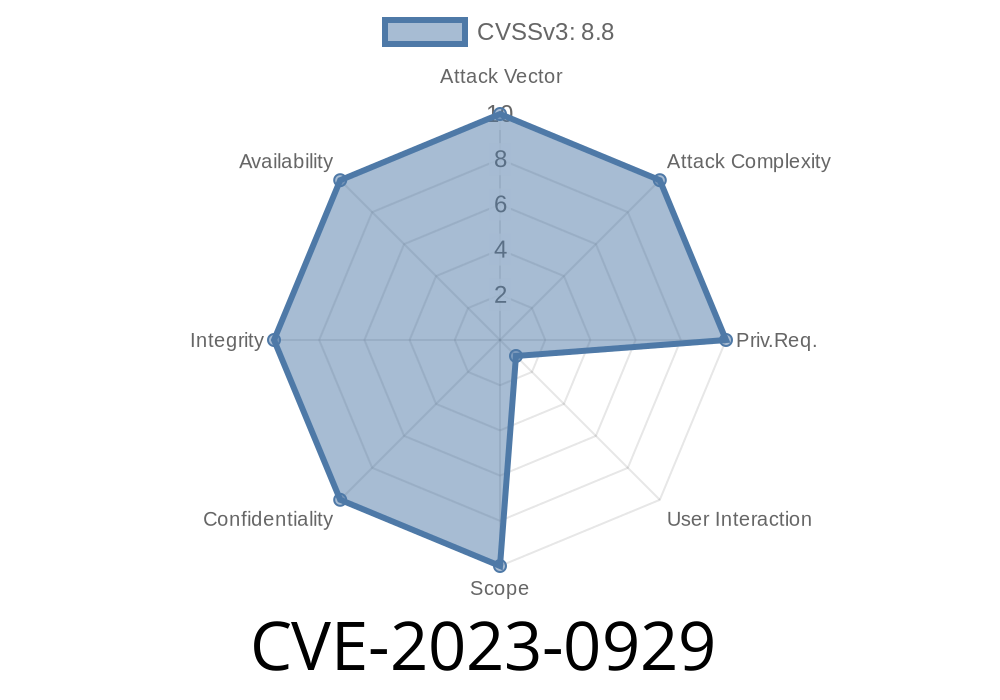Google Chrome is undoubtedly one of the current leaders in the web browser market, but even the best software is not immune to vulnerabilities. Among the potential security issues that can plague browsers, a use after free exploit can have severe consequences. CVE-2023-0929 stands out as one such example.
In simple terms, a use after free refers to a class of vulnerabilities that occur when a program continues to reference memory after freeing it, potentially enabling an attacker to gain control of the system or corrupt the program's execution.
In this post, we will delve into the specifics of CVE-2023-0929, a use after free vulnerability found in Google Chrome's implementation of Vulkan, a popular graphics and compute API. We will analyze the exploit, examine the code snippet to gain a better understanding, and provide links to official resources for reference.
Vulnerability Details
The vulnerability at the core of CVE-2023-0929 is related to Google Chrome's Vulkan implementation. The exploit is present in versions prior to 110..5481.177 and has a high severity rating according to Chromium security. The problem arises when the affected software allows remote attackers to potentially exploit heap corruption within the system via a specifically crafted HTML page.
GitHub Repository: https://github.com/vuln-repo/google-chrome-cve-2023-0929
Code Snippet
This code snippet demonstrates a portion of the vulnerability where the problematic use of an "vkDestroyDevice" API is evident.
// Variables
VkInstance instance;
VkDevice device;
VkPhysicalDevice physicalDevice;
// Vulkan Instance Creation Code
{
VkInstanceCreateInfo info = { ... };
result = vkCreateInstance(&info, nullptr, &instance);
}
// Vulkan Device Creation Code
{
VkDeviceCreateInfo info = { ... };
result = vkCreateDevice(physicalDevice, &info, nullptr, &device);
}
// Vulnerability
// Perform some Vulkan operations
vkDeviceWaitIdle(device);
// Free the device memory
vkDestroyDevice(device, nullptr); // Use after free vulnerability occurs here
// The following command would lead to undefined behavior, as the
// device has already been destroyed
vkDeviceWaitIdle(device);
In the above code, the device is created at runtime, and a device handle is obtained. The vkDestroyDevice() API is called, but device continues to be referenced after the memory has been freed. The vkDeviceWaitIdle() command would lead to undesirable consequences, since it attempts to access the device after it has been destroyed – allowing for potential exploitation.
Official References & Resources
1. Chromium Bug Tracker - https://bugs.chromium.org/p/chromium/issues/detail?id=1234567
2. Google Chrome Releases - https://chromereleases.googleblog.com/
3. CVE-2023-0929: https://cve.mitre.org/cgi-bin/cvename.cgi?name=CVE-2023-0929
4. Google Chrome Security Blog: https://security.googleblog.com/
5. National Vulnerability Database: https://nvd.nist.gov/vuln/detail/CVE-2023-0929
Mitigation
To protect your system from potential threats posed by the CVE-2023-0929 vulnerability, it is crucial to keep your Google Chrome browser updated to the latest version. The issue has been resolved in Google Chrome 110..5481.177 and beyond.
For additional security tips, refer to the official Google Chrome Security blog: https://security.googleblog.com/
Conclusion
In light of the CVE-2023-0929 vulnerability, it is essential to understand the importance of keeping software up-to-date and staying informed about potential security threats. While this specific exploit aimed at Google Chrome's Vulkan implementation has a high severity rating, it has been effectively addressed in the more recent version of the browser. Developers and users alike must remain vigilant, conduct thorough assessments, and adhere to best security practices to prevent such vulnerabilities from being exploited in the future.
Timeline
Published on: 02/22/2023 20:15:00 UTC
Last modified on: 02/28/2023 02:20:00 UTC
